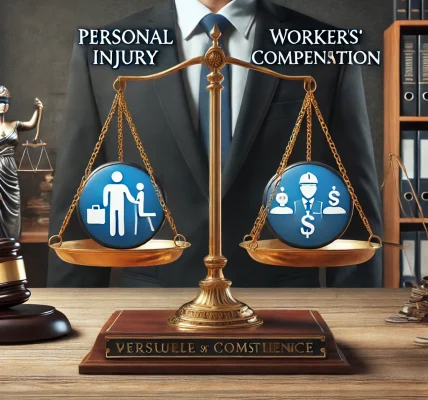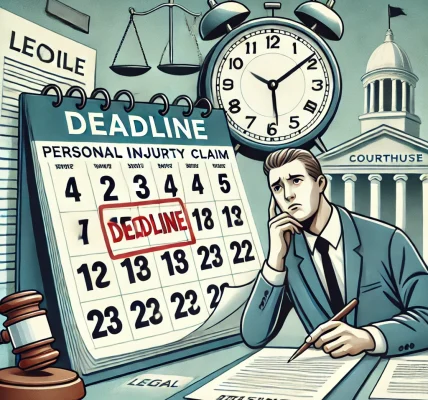Introduction
If you’ve suffered an injury due to someone else’s negligence, filing a personal injury claim can help you recover compensation for medical expenses, lost wages, and other damages. However, waiting too long to take legal action can jeopardize your case due to the statute of limitations—a legal deadline for filing lawsuits.
In this guide, we’ll explain what the statute of limitations is, why it matters, how deadlines vary by state and case type, and exceptions that may extend or shorten the filing period. Understanding these rules is crucial to ensuring your claim remains valid and enforceable.
What is the Statute of Limitations?
The statute of limitations is a legal time limit within which a plaintiff must file a lawsuit. If you fail to file within this period, the court will likely dismiss your case, and you may lose the right to seek compensation.
The statute of limitations serves several purposes:
- Ensures timely resolution of legal claims
- Protects defendants from unfair legal actions years after an incident
- Encourages claimants to present fresh evidence and witnesses
For personal injury cases, the time limit typically starts from the date of the accident or injury. However, exceptions exist depending on specific circumstances.
How Long Do You Have to File a Personal Injury Claim?
The time limit for filing a personal injury claim varies by state and type of injury. Here’s an overview of general deadlines:
| State | Statute of Limitations (Personal Injury Cases) |
|---|---|
| California | 2 years |
| Texas | 2 years |
| New York | 3 years |
| Florida | 4 years |
| Illinois | 2 years |
| Pennsylvania | 2 years |
For the most accurate information, check your state’s laws or consult a personal injury attorney.
Statute of Limitations Based on Case Type
The time limit for filing a personal injury claim depends on the type of injury case:
1. Car Accidents
- Most states allow 2-4 years to file a claim after a car accident.
- The clock starts ticking from the date of the crash.
2. Medical Malpractice
- Deadlines vary but typically range from 1-3 years.
- Some states use a “discovery rule“—the clock starts when the injury is discovered, not when it occurred.
3. Slip and Fall Accidents
- The statute of limitations is usually 2-3 years.
- The timeframe starts from the date of the injury.
4. Workplace Injuries
- If covered under workers’ compensation, you must report the injury within days and file a claim within 1-2 years.
- If you file a personal injury lawsuit against a third party (e.g., equipment manufacturer), the state statute of limitations applies.
5. Wrongful Death Claims
- The filing deadline usually ranges from 1-3 years.
- The clock typically starts from the date of death rather than the date of injury.
6. Claims Against Government Entities
- Special rules apply when suing city, state, or federal governments.
- Deadlines are usually much shorter—30 to 180 days to file a formal notice.
Exceptions to the Statute of Limitations
Certain circumstances may pause (toll) or extend the filing deadline for a personal injury claim:
1. Discovery Rule
- If an injury is not immediately discovered, the statute of limitations starts from the date of discovery.
- Common in medical malpractice and toxic exposure cases.
2. Minors and Legal Incapacity
- If the injured person is a minor, the statute of limitations may not begin until they turn 18.
- If a person is mentally incapacitated (e.g., in a coma), the deadline may be extended.
3. Defendant Leaves the State
- If the at-fault party leaves the state before a lawsuit is filed, the statute of limitations may be paused until they return.
4. Fraud or Concealment
- If the responsible party concealed evidence or misled the victim, the statute of limitations may be extended.
What Happens If You Miss the Deadline?
If you file a lawsuit after the statute of limitations expires, your case will likely be dismissed. This means:
- You lose the right to compensation.
- The defendant is no longer legally responsible for your injury.
- Exceptions are rare, so acting quickly is essential.
How to Protect Your Legal Rights
To ensure your claim is valid and filed on time, follow these steps:
1. Seek Medical Attention Immediately
- Medical records are crucial evidence.
- Delaying treatment may weaken your case.
2. Consult a Personal Injury Attorney
- An experienced lawyer ensures deadlines are met.
- They help gather evidence, negotiate settlements, and file lawsuits.
3. Gather Evidence Quickly
- Take photos/videos of injuries and accident scenes.
- Collect witness statements, police reports, and medical records.
4. File an Insurance Claim Promptly
- Most insurance companies have their own deadlines for claims.
- Waiting too long may result in claim denial.
5. Check Your State’s Laws
- Every state has different rules and deadlines.
- Government claims have shorter filing windows.
Conclusion
Understanding the statute of limitations is essential for protecting your legal rights and securing compensation for your injuries. Since deadlines vary by state and case type, taking immediate action is crucial.
If you’ve been injured, consult a personal injury attorney as soon as possible to avoid missing deadlines and maximize your chances of a successful claim. Waiting too long could cost you the compensation you rightfully deserve.
By acting promptly, staying informed, and working with a legal professional, you can navigate the complexities of personal injury law with confidence.




